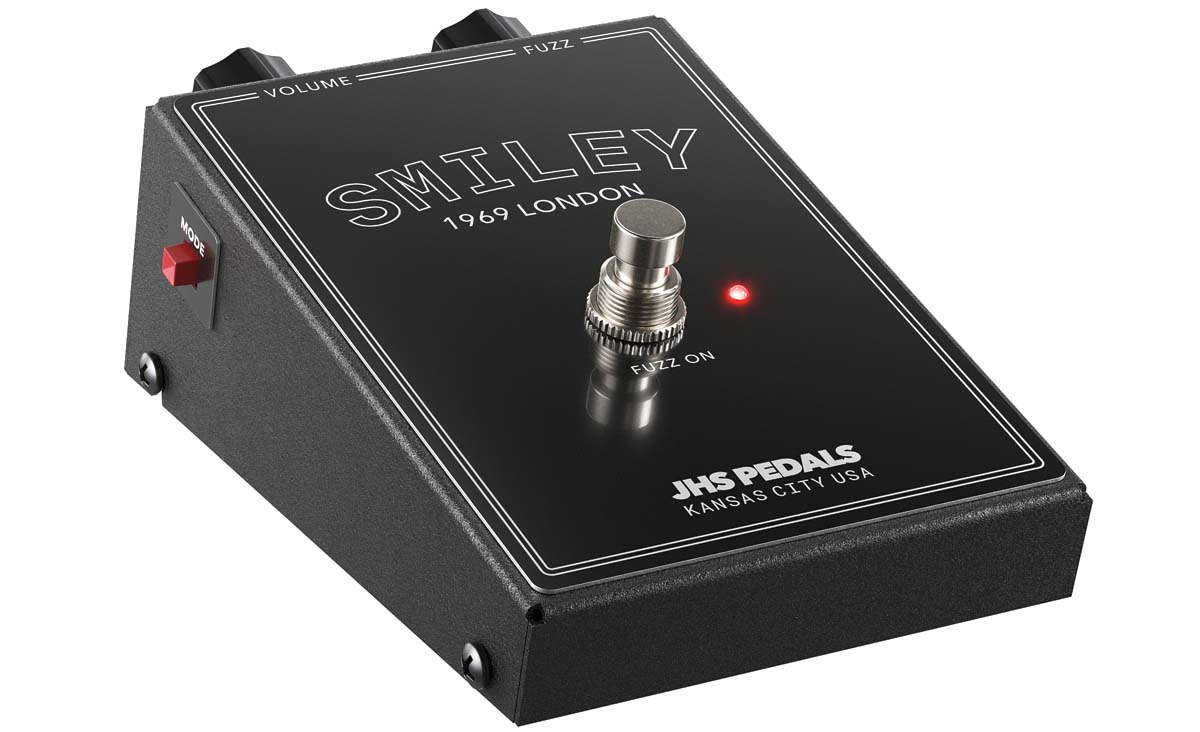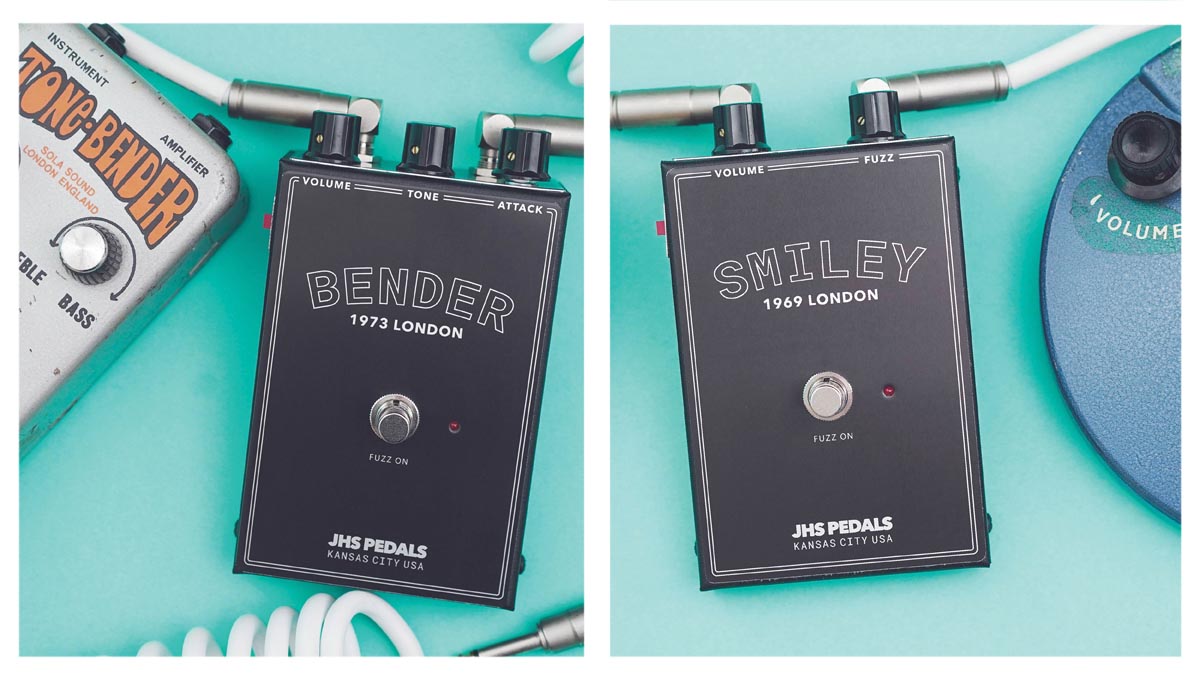GuitarPlayer Verdict
As a veritable tone Tardis for vintage-fuzz enthusiasts to sample the grip 'n' dirt of the late Sixties and early Seventies, the Legends of Fuzz series is hard to beat. Sharing a similarly fun and tastefully simple retro package, Bender and Smiley are exceptional, proving classic fuzz never goes out of style.
Pros
- +
Bender is a thick, meaty, aggressive vintage-toned fuzz.
- +
Bonus gain mode.
- +
Smiley nails warm, woolly late-’60s Fuzz Face tone.
Cons
- -
Though period accurate, Smiley has no option for extra brightness/bite.
You can trust Guitar Player.
Introduced in the early 1960s, the fuzz box was one of the first genuine solid-state effects pedals for guitar. It speaks to its expressiveness that the effect has remained both timeless and eternally in fashion in at least one prominent genre of popular music (and sometimes several) for the better part of six decades.
The sound of a good fuzz pedal never seems to wear thin, and time and again it has been at the forefront of the latest wave of guitar-fueled fury as practiced by players ranging from Keith Richards and Jimi Hendrix to Billy Corgan and Jack White, and beyond.
Pedal maker JHS is celebrating the many-splendored world of fuzz with retro-styled re-creations of four gnarly noisemakers in its Legends of Fuzz series, the two most seminal of which we took under foot this issue.


JHS is known for its creative and occasionally complex effects pedals, but those in the Legends of Fuzz series – all of which are based on analysis of several original pedals in proprietor Josh Scott’s collection – signal what the company sees as a “post-boutique” wave.
Says Scott, “I feel like maybe we’re coming back around and people are going to start playing simple stuff again. Everything’s cyclical. It’s like you go for 10 years and then you want simple again. That’s how it’s been since the ’60s.”
Simple it may be, but a good fuzz pedal offers tremendous sonic potential, and these Bender and Smiley pedals are no exception.
I tested both with a Fender 40th Anniversary 1954 Stratocaster reissue and a Gibson 1958 Les Paul reissue into the Plexi-like clean channel of a Friedman Small Box head and a 2x12 cab with Scumback speakers.
All the latest guitar news, interviews, lessons, reviews, deals and more, direct to your inbox!
Bender

Subtitled “1973 London,” the Bender takes its inspiration from what Scott calls the most prized Tone-Bender in his collection, a silver-and-orange 1973 Sola Sound Tone-Bender Mk3.
The original was manufactured with three germanium transistors, which could sound fabulous when they were in the mood to cooperate, but could also prove finicky and temperamental.
For the sake of consistency and dependability, JHS transmuted the circuit into a modern PCB using silicon transistors, while adding true-bypass switching, an LED indicator, and a nine-volt DC converter input (with an internal nine-volt battery clip for old-school power).
Controls, all on the front-facing panel, include attack (fuzz level), tone, and volume. A red push-button switch on the side of the pedal engages a JHS mode for added gain and a midfrequency boost.
The pedal is housed in a simple, wedge-shaped, bent-steel enclosure with a black crinkle-coat finish. Circuit nerds will enjoy opening the bottom plate to discover three legends printed around the edge of the PCB: “Gary Hurst was here… kinda… / My father was Ge but I am Si. Will I ever live up to his standards? / Thank you Denmark Street for giving me a chance.”
The first and third refer, of course, to the engineer who created the original Tone-Bender in the back room of Macari’s Music at Denmark Street, London, in 1965, while the second is a reference to the change from germanium to silicon transistors.
The first 100 or so of Hurst’s original Tone-Benders were made inside wedge-shaped wooden boxes and can cost upward of $15,000 to $20,000 on the vintage market – if you can find one.

Stomp the Bender’s Fuzz On switch and the pedal yields a blend of razory bite and slightly raspy edge that gives cutting power to this fuzz’s thick, snarling core tonality, all of which combines to embody a familiar classic-rock sound of the early to mid ’70s.
Think Jimmy Page on much of Led Zeppelin’s recordings of the era, Jeff Beck’s expressive fuzz work, or Mick Ronson’s lead sound with Ziggy Stardust–era David Bowie, and you’ll be in the ballpark.
Bender enables an expressive, vocal, woodwind-like sound that makes for delightfully moody soloing
This pedal works equally well with the Strat and Les Paul, and also did a great job of the woman-tone fuzz when I rolled the tone controls on either test guitar down to zero, where the Bender enables an expressive, vocal, woodwind-like sound that makes for delightfully moody soloing.
As with many good fuzz pedals, it cleans up surprisingly well from a guitar’s volume controls, too, allowing a textured enhancement that’s a little more characterful than the guitar-to-amp clean sound with the fuzz switched off.
The pedal’s own tone control is useful as well, dialing between a voicing that’s cutting and bright and one that’s warm and mellow. Engaging the JHS mode boosts gain and midrange, as advertised, and provides a handy second voice. Trigger it on the fly if you’re wearing pointy-toed boots, as should any user of classic early ’70s fuzz.
Smiley

Subtitled “1969 London,” the Smiley recreates the late-’60s iteration of the legendary Arbiter Fuzz Face, whose circuit featured silicon transistors, giving it the tighter, crispier tone Jimi Hendrix was said to prefer.
Smiley’s construction and features are like Bender’s, other than its inclusion of just two control knobs, like the original, for fuzz and volume. Also slightly different, the JHS mode engaged with its left-side push-button switch induces a severely gated high-gain fuzz tone.
Removing the bottom panel also reveals hidden inscriptions on the edges of the circuit board: “Turn it up to ten! / Fuzz came to us from different lands, like England, the United States and even Japan.” A bit of advice, and some instructive history.
Plugged in, the Smiley exudes a smooth, round, ball-of-hair fuzz tone that harkens to a slightly earlier era than that of the Bender, reminding us why many early fuzz pedals were marketed as a way to make your guitar sound like a sax or trombone.

This one likes to have its volume control pushed to three-quarters or beyond to get the juice flowing, where it becomes a bit more articulate and transparent, while sounding hotter overall.
The Smiley leans a little dark with the Les Paul, though it can still be richly expressive, but the ’50s-style Strat’s bright single-coil pickups bring a lot more cutting power to the fray, this partnership arguably making the Smiley more versatile.
Like the Bender, the Smiley does a great woman tone, and it responds well to the guitar’s volume control. It’s a pretty spitty, spluttery fuzz circuit to begin with, which is part of the fun, but engaging that JHS mode button slips it into a super-voltage-starved gated mode that can be a blast, if something of a novelty.
All in all, these two examples of the Legends of Fuzz series admirably dunk us into vintage-fuzz waters and provide some fun playing experiences, along with easy access to dependable new simulations of classic sounds that remain very usable on today’s pedalboards.
Specifications – JHS Pedals Legends of Fuzz Bender
- PRICE: $179 street
- CONTROLS: Volume, tone, attack. Mode switch
- I/O: Input and output, center-negative 9-volt DC adaptor input
- EXTRAS: True-bypass switching, LED indicator
- BUILT: Assembled in USA
Specifications – JHS Pedals Legends of Fuzz Smiley
- PRICE: $179 street
- CONTROLS: Volume, fuzz, Mode switch
- I/O: Input and output, center-negative 9V DC adaptor input
- EXTRAS: True-bypass switching
- BUILT: Assembled in USA
- CONTACT: JHS Pedals
Dave Hunter is a writer and consulting editor for Guitar Player magazine. His prolific output as author includes Fender 75 Years, The Guitar Amp Handbook, The British Amp Invasion, Ultimate Star Guitars, Guitar Effects Pedals, The Guitar Pickup Handbook, The Fender Telecaster and several other titles. Hunter is a former editor of The Guitar Magazine (UK), and a contributor to Vintage Guitar, Premier Guitar, The Connoisseur and other publications. A contributing essayist to the United States Library of Congress National Recording Preservation Board’s Permanent Archive, he lives in Kittery, ME, with his wife and their two children and fronts the bands A Different Engine and The Stereo Field.


